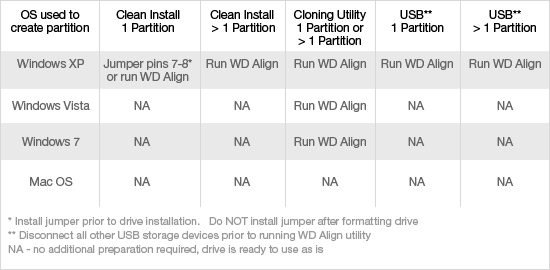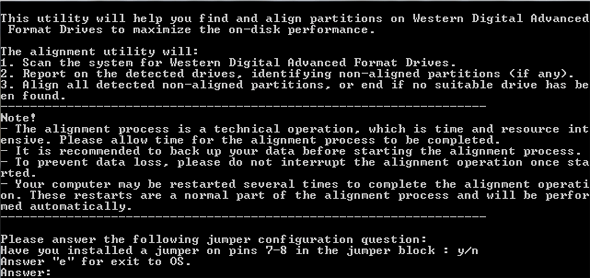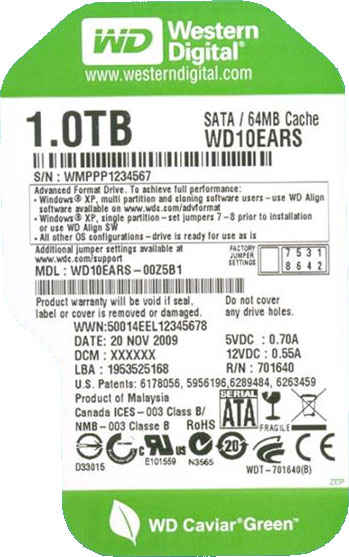Western Digital’s Advanced Format: The 4K Sector Transition Begins
by Ryan Smith on December 18, 2009 12:00 AM EST- Posted in
- Storage
What Operating Systems Are Affected
Now that we’ve dealt with what 4K sectors are, why Western Digital and other drive manufacturers are switching to them, and what the potential pitfalls of 512B emulation are, we can look at the specific cases where there are potential problems.
The big problem is that while the first work on 4KB sectors started in 1998, it wasn’t until after the launch of Windows XP that the matter came to a head. As a result the 5.x versions of Windows (2K, XP, 2K3, WHS) have no concept of 4KB sectors. Even though all operating systems will be seeing 512B sectors through the use of emulation technology on the drive controller, out of Windows only Win 6.x (Vista, 2008, Win7) and later have been programmed to take in to account the alignment issues we mentioned earlier. Win 5.xx in particular has a nasty habit of starting the first partition at LBA 63, which is 1 512B sector misaligned from a 4K sector boundary. In essence, the issue is that Win 5.x will always create a misaligned first partition and will have poor default performance as a result.
Although Win 5.x is the primary victim here, other versions of Windows can also be affected in edge cases. Along with the need for 4K-aware operating systems, drive imaging software needs to be 4K-aware. Otherwise such imaging software may inadvertently create misaligned partitions too. As such, Win 6.x is also affected by alignment issues when imaging software is used, as some (and perhaps all?) imaging products currently available will write misaligned partitions and/or clusters.

Notably, Linux and Mac OS X are not affected by this issue. Western Digital has tested both of these operating systems, and officially classifies them as not-affected. Ultimately we suspect that if you went back far enough you could find older versions of these OSes that are affected, but unlike Win 5.xx, there’s not a significant legacy user base to worry about. Along these lines, Linux and Mac OS X drive imaging products are similarly unaffected. In their testing, imaging tools such as SuperDuper didn’t run in to any alignment issues, so Linux and Mac OS X users are not affected in any way by 4K sectors. It’s only Windows and Windows imaging products that are affected.
In order to solve the misalignment issue, Western Digital is offering two solutions. The first solution for correcting misaligned partitions is specifically geared towards Win 5.x, and that is an option on the drive itself to use an offset. Through the jumpering of pins 7 and 8 on an Advanced Format drive, the drive controller will use a +1 offset, resolving Win 5.xx’s insistence on starting the first partition at LBA 63 by actually starting it at LBA 64, an aligned position. This is exactly the kind of crude hack it sounds like since it means the operating system is no longer writing to the sector it thinks its writing to, but it’s simple to activate and effective in solving the issue so long as only a single partition is being used. If multiple partitions are being used, then this offset cannot be used as it can negatively impact the later partitions. The offset can also not be removed without repartitioning the drive, as the removal of the offset would break the partition table.
The second method of resolving misaligned partitions is through the use of Western Digital’s WD Align utility, which moves a partition and its data from a misaligned position to an aligned position. This is the recommended solution for using multiple partitions under Win 5.xx, along with correcting any misaligned partitions generated by imaging software. For that matter we’d consider it the recommended solution for single-partition drives being used under Win 5.x too, as there’s no need to worry about offsets and breaking the partition table.

The utility is available for download from Western Digital’s site, and while it isn’t pretty (it’s a scripted CLI application) it gets the job done. The amount of time needed to run the utility is based on the amount of data that needs to be moved rather than the partition size (it simply ignores empty space), so it’s best to run the utility immediately after creating a partition or installing Windows, as there’s less data to move around.
Unfortunately, at this point the utility also serves as the only way to identify an Advance Format drive without physically looking at it. Looking at the ATA spec, it looks like there’s a provision for asking a drive its native sector size (regardless of 512B emulation) but at this point there’s no such tool beyond the WD Align utility itself. This in and of itself isn’t a big issue, but if you’re a techie that ever finds themselves working on an XP machine with a 1TB+ Western Digital drive, you’ll want to keep an eye open.
The First Drives & The Future
So what are the first Advanced Format drives and when are they due? The first drives will be Caviar Green drives using multiple 500GB platters – so the 1TB, 1.5TB, and 2TB Caviar Green. These drives will be shipping any day now, and can be identified through two different methods: 1) They all have 64MB of cache - the first WD Caviar Green drives to come with that much cache - and 2) They all have EARS in the drive model number, e.g. WD10EARS.

As we stated before, in spite of the benefits of 4K sectors, Western Digital is not pushing these drives as part of any major product launch. Rather they’re going to be quietly trickling in to the marketplace. Expect a price premium at first (as with any other new product) before settling down. We don’t have a drive on-hand to review, but from the fact that this is a low-key launch, WD isn’t painting any expectations of a performance difference, although this will be something to test in the future.
And on that note, expect to see similar launches from everyone else within the next year. The last IDEMA plan called for everyone to have 4K-sector drives by 2011, so everyone should be launching within the next year here. Everyone using 512B emulation is going to run in to the same teething issues with Win 5.x – so while other vendors may handle things slightly differently, ultimately everyone is going to be compensating for Win 5.x in some manner (in case it hasn’t been made clear here, these guys would be ecstatic for Win 5.x to go away quickly).
Farther down the road will be the exposure of 4K-sectors to the operating system itself. Linux and Win 6.x are set (and we believe that Mac OS X is too), the only limit right now is the desire to do a phased transition to make thing easier for legacy users. Since 4K-sector drives won’t work on Win 5.x at all, drive manufacturers can’t put them on the market so long as there’s a significant legacy base. 2014 – the year that extended support ends for WinXP – looks like a good year to finally complete the move to 4K sectors.










86 Comments
View All Comments
flynace - Friday, December 18, 2009 - link
So do these drives still run in 512k emulation mode under Win7?Or does Win7 recognize them as 4k drives thus partitioning and formating them accordingly?
Ryan Smith - Friday, December 18, 2009 - link
They still run in 512B emulation. The emulation is done at the drive controller level; with these WD drives it can not be disabled. Win7 is only aware to the point that it knows not to start a partition at a misaligned logical sector.therealnickdanger - Friday, December 18, 2009 - link
Hmm, OK I misread the article. I thought that Windows Vista/7 properly addressed 4KB chunks and it was only XP that was stuck in 512B emu-hell. So the new drives operate at 4KB at the hardware level, but regardless of OS, they are 512B at the interface level? Do we need to wait then for the next batch of WD drives that operate and interface at 4KB in order for Vista/7 to take advantage of this?I'm really looking forward to the 20% bump in useable storage space.
Candide08 - Friday, December 18, 2009 - link
Wouldn't the 20% increase in storage still be realized - as long as the drives platters are formatted with the 4k sectors?The interface would be breaking the 4k transfers into 512 byte chunks for backwards compatibility, at a bit of a performance cost.
When the 4k interfaces are released then the full performance gains will be realized in addition to the storage efficiency increases, yes?
Lukas - Sunday, December 20, 2009 - link
Yes. I'd also expect WD to ship some Black Edition drives that will be configurable between 512/4096 sectors on the interface, a long time before all shipped drive will default to 4096.Ryan Smith - Friday, December 18, 2009 - link
Yes, you need to wait for WD to ship drives that enable 4K sectors at the interface level. Due to the number of Win 5.x machines still in existence, this is likely a few years off in order to avoid the resulting grief for drive manufacturers. I suspect we're looking at 2014, but it could certainly be earlier.mczak - Friday, December 18, 2009 - link
I'm not sure exactly how 4K sectors will be exposed to the OS, but if the commands accessing the disks are different they could expose this without impacting old OS (by supporting both 512 and 4K access). Even if that's not possible, certainly WD could have made this switchable by jumper, so I can't see why WD would need several years to wait here.In theory I guess 4K access should be faster (less command i/o) or at least have less cpu overhead, but maybe the gains just aren't significant at all hence WD didn't bother.
azmodean - Friday, December 18, 2009 - link
This is just a little bit misleading, (probably not intentionally though). The current batch of drives will store data in 4K chunks, but will allow the OS to use 512-byte aligned addresses. You will still get the effective capacity increase and improved error correction in the drive, this is transparent to the OS. From what I can tell the only problem is that the drive itself has to work harder, and that there are some newer file systems that can optimize things further if they had a 4K interface size.Summary:
With the current batch of drives you get the space and ECC benefits of 4K sectors, but with some minor problems related to translation, which buys you compatibility with win XP.
With the next version of the tech (no idea when this will appear), the drives will remove the compatibility mode, and advanced filesystems will be able to optimize things further.
therealnickdanger - Friday, December 18, 2009 - link
Let's hope so! Thanks for clarifying things for my simple brain. ;-)cjb110 - Friday, December 18, 2009 - link
Couldn't the OS issue be fixed in a patch or service pack?If all manufactures will be going to 4k then it seems like Microsoft needs to start working on a proper fix for this. Rather than leaving to the manfuactures, which might end up producing a multitude of different 'fixes'.